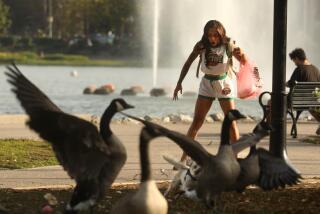Experts Band Together on a Wild Goose Chase of Sorts
- Share via
SACRAMENTO NATIONAL WILDLIFE REFUGE, Calif. — Wildlife biologist Greg Mensik was sitting in his pickup truck atop a levy overlooking one of several huge ponds on this federal wildlife sanctuary near the Northern California town of Willows.
“I got a Soviet bird dead center in the scope,” he shouted. He jotted down 7C9 in his notebook, which correspond to marking on the bird’s collar.
The big, snowy-white waterfowl with black wing tips had flown thousands of miles south from Wrangel Island, the Soviet Union’s remote, most northeastern Arctic island. Between 75,000 and 100,000 of the snow geese come to California each winter.
Upward of 10,000 raucous, honking snow geese and smaller Ross geese cover the pond. The cacophony of the flock is deafening.
“Another Wrangel Island goose, OC4,” said Mensik of the U.S. Fish and Wildlife Service as he peered through his spotting scope and entered the identification code in his log. A minute later: “There’s a black collar, 88A, a Canadian bird.” A few minutes after that he spotted a goose with a blue collar marked TE42 from Alaska’s North Slope.
Mensik is one of several wildlife biologists from the United States, the Soviet Union, Canada and Mexico keeping track of the far-flying flocks that nest and breed near the top of the world and winter in southern Canada, northern Washington, California and as far south as Mexico.
Snow geese are the most abundant of wintering geese in California with most found in the Central Valley north of Sacramento. As many as 300,000 snow geese winter on Pacific Flyway refuges. An adult snow goose weighs about 6 pounds, with a 4-foot wing span.
Wrangel Island off the Siberian coast is home to the Soviet Union’s only snow goose population. Called Ostrov Vrangelya by the Russians, the island was discovered by an American whaler in 1867. Later, Canada claimed it but since 1924 the island has belonged to the Soviet Union. In recent years, most of the Eskimos and reindeer that once inhabited the island have been removed. Wrangel Island is now a Soviet national preserve.
The first major international effort to monitor the migration of snow geese is just now starting. “We’re trying to sort out where the various colonies of snow geese fly to each winter. We’ve a pretty good idea that four-fifths of the snow geese from Wrangel Island wind up in California,” said James C. Bartonek, Pacific Flyway representative for the federal Fish and Wildlife Service in Portland, Ore.
Bartonek worked with Soviet scientists for several years to forge an agreement to monitor the geese and to try to get an accurate count of the number of birds that make the journey. He shipped banding collars to Wrangel Island for placement on the Soviet geese.
“We made 1,000 collars for Wrangel Island, 3,000 collars for Alaska and Canada,” said Bruce Deuel, assistant waterfowl coordinator for the California Department of Fish and Game. The collars with red letters and numbers signify snow geese from Wrangel; black numbers and letters for Canada and blue for Alaska. The greatest numbers of snow geese come from Canada’s Arctic, mostly from Banks Island. Next are the Wrangel Island geese; the smallest numbers are from Alaska’s Prudhoe Bay.
Dick Kerbes is Canada’s snow goose expert, with the Canadian Wildlife Service in Saskatoon, Saskatchewan. He just returned from studying small populations of wintering snow geese in Mexico.
Three Soviet scientists spent November with Kerbes monitoring snow geese from Wrangel Island as they migrated through Canada. Kerbes hopes to visit Wrangel Island this summer. This summer, two American wildlife biologists will spend time studying Russian breeding and nesting populations on Wrangel. In November and December Russian scientists will come to California to study wintering flocks of snow geese from Wrangel Island.
Snow geese mate for life and migrate in small family groups numbering from less than 100 to more than 10,000. The flocks travel at 50 miles an hour or more.
Although various colonies of snow geese from the Soviet Union, Canada and Alaska mix on wintering grounds with one another and with Ross geese, they return to original breeding and nesting grounds in the Arctic in the spring.
“They remain here from late October to March feeding by day on rice and grain stubble in the valley, leftovers after farmers harvest their crops,” said biologist Mensik. The geese also feed on 300 acres of rice planted for them on the refuge. At night and during afternoons snow geese sleep on the ponds.
Mensik has been working with snow geese for 12 years. “There isn’t a more spectacular sight than seeing great numbers of snow geese on ponds or flying above in huge flocks. I never tire of it,” he said.
More to Read
Sign up for Essential California
The most important California stories and recommendations in your inbox every morning.
You may occasionally receive promotional content from the Los Angeles Times.













